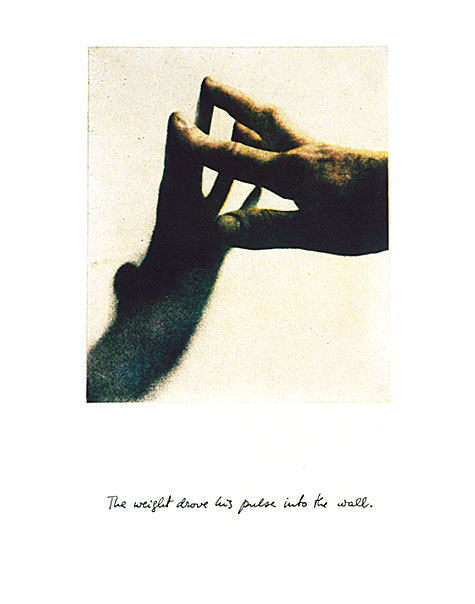
Luis Camnitzer, from the Uruguayan Torture Series, 1983-84. 35 photoengravings, 29 1/2 x 21 11/16” each. Courtesy of Alexander Gray Associates, New York.
Over the last five decades, pioneering conceptual artist Luis Camnitzer has earned an international reputation for his subtly biting prints, multiples and sculptural works that combine poetic lyricism with political and social engagement.
This spring, Camnitzer will receive the Printmaker Emeritus Award during the 2011 annual conference of the Southern Graphics Council International (SGCI) March 16-19 at Washington University in St. Louis’ Sam Fox School of Design & Visual Arts.
In recognition, the university’s Mildred Lane Kemper Art Museum has organized Luis Camnitzer: Forewords and Last Words, an exhibition of works spanning the career of this influential artist.
On view through April 18, the exhibition is curated by Buzz Spector, the Jane Reuter Hitzeman and Herbert F. Hitzeman, Jr., Professor of Art and dean of the College and Graduate School of Art, and highlights Camnitzer’s distinctive interweaving of wit, wordplay and sociopolitical critique.
For example, Envelope (1967), the earliest work on view, consists of 10 etchings in which a minimal, unchanging line drawing of a square-within-a-square is paired with a different word on each sheet. Thus in the viewer’s perception, the titular “envelope” becomes a box, cube, grid, painting, roof, room, screen, tunnel and window.
Similarly, Camnitzer’s Image—English Dictionary (1971), a suite of six etchings, consists of simple pictograms joined with short, ambiguous legends.
For example, a small drawing of an empty square is accompanied by a list of potential descriptors: “Mesa, Plaza, Pozo, Prisma, Techo, Unidad, Zona” (Table, Square, Well, Prism, Roof, Unity, Zone).
Meanwhile, the arresting Uruguayan Torture Series (1983-84), made in response to the violence inflicted by Uruguay’s former dictatorship, includes 35 photoengravings, each paired with a short text, that together suggest the terrifyingly intimate relationship between tortured and torturer. Last Words (2008), the most recent work on view, comprises six large-scale digital prints in which the final statements of death row prisoners are reproduced.
Luis Camnitzer
Born in Lübeck, Germany, in 1937, Camnitzer immigrated with his family to Montevideo, Uruguay, at the age of two. After studying sculpture and architecture at the Escuela Nacional de Bellas Artes (National School of Fine Arts) in Montevideo’s Universidad de la Republica, Camnitzer won a grant to study at the Academy of Munich. In 1961, he received a Guggenheim fellowship in printmaking and three years later settled in New York, where he continues to live and work.
Camnitzer has staged solo shows at the Galería Ruth Benzacar, Argentina; The Kitchen and El Museo del Barrio, both in New York; the List Visual Arts Center at the Massachusetts Institute of Technology; and Museo Carillo Gil, Mexico City. In addition, retrospective exhibitions have been presented at the Lehman College Art Gallery in the Bronx (1991); Kunsthalle Kiel, Germany (2003); the Daros Museum in Zürich (2010); and El Museo del Barrio (2011).
In addition, Camnitzer’s projects have been featured in major international exhibitions, including Information (1970) at The Museum of Modern Art, New York; the Biennial of Havana, Cuba (1984, 1986, and 1991); the Whitney Biennial (2000); Documenta 11 (2002); and Beyond Geometry (2005) at the Los Angeles County Museum of Art.
One of the founders of the New York Graphic Workshop, Camnitzer has served as curator for the Viewing Program at the Drawing Center.
He is currently a professor emeritus at SUNY College at Old Westbury as well as pedagogical curator for the Iberé Camargo Foundation in Porto Alegre, Brazil. An influential critic and theorist, Camnitzer is a frequent contributor to ArtNexus and author of New Art of Cuba (1994, 2003) and Conceptualism in Latin American Art: Didactics of Liberation (2007).
Mildred Lane Kemper Art Museum
The Mildred Lane Kemper Art Museum is committed to furthering critical thinking and visual literacy through a vital program of exhibitions, publications and accompanying events. The museum dates back to 1881, making it the oldest art museum west of the Mississippi River. Today, it boasts one of the finest university collections in the United States.
Supporters
Support for Luis Camnitzer: Forewords and Last Words is provided by Bunny and Charles Burson, Washington University’s Sam Fox School of Design & Visual Arts, and members of the Mildred Lane Kemper Art Museum.
Luis Camnitzer: Forewords and Last Words remains on view through April 18. The exhibition is free and open to the public. The Kemper Art Museum is located on Washington University’s Danforth Campus, near the intersection of Skinker and Forsyth boulevards. Regular hours are 11 a.m. to 6 p.m. Mondays, Wednesdays and Thursdays; 11 a.m. to 8 p.m. Fridays; and 11 a.m. to 6 p.m. Saturdays and Sundays. The Museum is closed Tuesdays.
For more information, call (314) 935-4523 or visit kemperartmuseum.wustl.edu.
|
WHO: Mildred Lane Kemper Art Museum WHAT: Exhibition, Luis Camnitzer: Forewords and Last Words WHEN: Through April 18 WHERE: Mildred Lane Kemper Art Museum, Washington University in St. Louis, near the intersection of Forsyth and Skinker boulevards. HOURS: 11 a.m. to 6 p.m. Monday, Wednesday and Thursdays; 11 a.m. to 8 p.m. Fridays; 11 a.m. to 6 p.m. Saturdays and Sundays. Closed Tuesdays. COST: Free and open to the public. INFORMATION: (314) 935-4523 or kemperartmuseum.wustl.edu |